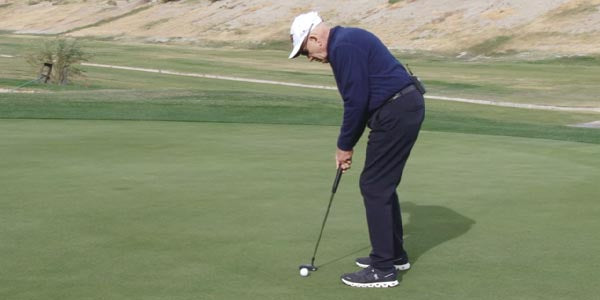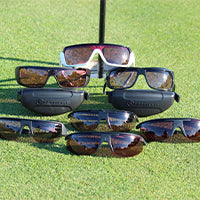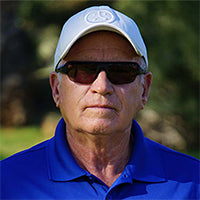Free home try-on available! No upfront payment, free & easy returns
Free home try-on available! No upfront payment, free & easy returns
Product Features
EXPLORE THE LEARNING CENTER
Essential Golf Tips and Techniques: The Journey to the Green
by Popticals 6 min read
Inside this Article:
Achieving success in golf demands an unwavering focus on every detail at every location on the course. While Popticals NYDEF® Golf Learning Center focuses primarily on putting and the related insights of renowned putting instructor, Dr. Craig Farnsworth, we know success on the golf course extends to every shot at every step of each hole.
Avid golfers understand that the journey from tee to green is a sequence of calculated decisions, considering factors such as wind direction, elevation changes, yardage, and club selection. It's akin to a chess game played on finely manicured landscapes, where each move demands careful forethought and strategic concentration.
This article takes a deeper dive into the factors players should consider while planning their tee and approach shots. From navigating the natural elements to figuring out where to miss strategically, these factors play a pivotal role in successfully maneuvering the course from tee to green.
Planning for Success Off The Tee
Players should consider the following seven factors while they are planning their tee shots:
When strategizing tee shots, golfers must carefully consider a multitude of factors to optimize their performance on the course. Firstly, assessing the wind direction is paramount as players gauge whether adjustments are needed to take into account its influence on their ball flight.
Decisions on altering trajectory or sticking to a regular shot depend on the prevailing wind conditions, their direction and strength. Winds may steer the ball toward hazards or bring bunkers into play that otherwise would not be concern. In instances of high winds, a thoughtful selection of a different club may be necessary as well.
Recognizing that each day on the golf course is unique, golfers must adapt to varying course conditions. Whether the fairways are dry and baked out or appear dark and muddy will significantly impact the ball's rollout on tee shots. Elevation changes add another layer of complexity, prompting players to consider adjustments in how far their drives will carry compared to a flat hole.
The slope of the fairway is another critical factor in tee shot planning. Instead of simply hitting their normal drive down the middle of the fairway, golfers may need to favor one side of the fairway or employ shot-shaping techniques like draws or fades to counteract the natural slope of the hole.
Strategic planning for the second shot is also important in the process, particularly on shorter par four's, where using a driver might position a player within 100 yards of the green. The decision between laying back or pushing a driver up farther to leave a shorter approach depends on the player’s iron and wedge ability and the firmness of the greens. Softer greens are suitable for shorter approaches while firmer conditions require more spin and would be easier to approach using a full second shot.
Bunker characteristics, including the color of the sand, play a role in tee shot considerations. Darker bunkers are generally firmer and easier to hit out of, making them less problematic for players. Lighter-colored bunkers, on the other hand, tend to be softer and can pose a greater challenge.
Lastly, golfers should factor in the hole location when planning their tee shots. Considering where the hole is cut allows players to choose the optimal approach angle, deciding whether to play from one side of the fairway to secure a better angle for the upcoming shot to the green.
By carefully considering these elements, golfers can make better informed decisions and strategically plan their tee shots for optimal performance on the golf course.
Planning for Success Approaching the Green
When golfers are strategizing their approach shots into the green, there are several crucial factors to consider for optimal shot-making.
First and foremost, players should select a conservative target while remaining aggressive towards that chosen target. It's essential to note that the target, though precise, is seldom the actual hole location unless the hole is centrally positioned on the green.
In the process of choosing the target, golfers need to factor in potential hazards surrounding the green, such as penalty areas, sand traps, thick rough, and swells. A keen observation of the slopes around the green is equally important, as areas surrounding the green can sometimes create optical illusions that blend into a sea of green saturation.
Moreover, the slope of the green plays a significant role in club, shot shape, and target selection. Darker sections of the green indicate an uphill slope, prompting the ball to stop quickly upon landing. Conversely, lighter and shinier sections signify a downhill slope, causing the ball to run out farther after landing.
Wind and elevation changes remain a crucial factor influencing club selection and distance control, demanding careful consideration from players. Hitting uphill or downhill as well as into the wind or downwind can affect club selection.
Considerations regarding the lie of the ball become crucial when players are selecting a club and target. Various factors influence distance and ball control, including:
-
A clean fairway lie typically results in an expected flight.
-
A dewy fairway lie may lead to a slightly shorter flight compared to a dry lie.
-
The first cut outside the fairway generally yields a few yards shorter distance, unless the ball is lying down grain, potentially causing it to jump. Mid or long irons are more prone to jumping, while a wedge typically exhibits a knuckling effect, coming up short.
-
A primary rough with a favorable lie often results in a jump and low-spin takeoff, leading to a longer-than-normal flight. Conversely, a bad lie in the primary rough usually produces a dead takeoff and considerably shorter distance. In both scenarios, low spin contributes to significant roll-out.
-
On Zoysia fairways, players typically experience a 3-5 yard increase in distance when hitting irons.
Key Takeaways
The Tee Shot
Wind Assessment: Carefully assess wind direction, considering adjustments to mitigate its influence. Wind strength and direction impact shot trajectory and may bring into play hazards that otherwise might not be at issue.
Course Conditions: Adapt to varying course conditions, including dry or muddy fairways, affecting the ball's rollout. Wet fairways will appear dark, where dry fairways will appear light and sometimes shiny.
Fairway Slope: Factor in the slope of the fairway, adjusting shot placement to counteract natural slopes. Consider shaping the shot into the slope to control the ball once it is on the ground.
Second Shot Strategy: Plan strategically for the second shot, especially on shorter par 4s. Decide whether to lay back or push with a driver based on iron and wedge ability and green firmness.
Bunker Characteristics: Consider bunker characteristics, including color. Darker bunkers are firmer and easier to hit out of, while lighter bunkers pose a greater challenge and should be avoided at all cost.
Hole Location: Factor in the hole location when planning tee shots to choose the optimal approach angle for the shot to the green.
Planning the Approach
Conservative Target: Choose a conservative target while remaining aggressive toward it. The target is rarely the hole location unless centrally positioned on the green.
Hazards and Surroundings: Factor in hazards around the green, such as penalty areas and sand traps. Consider the slopes around the green to avoid leaving a tricky up-and-down.
Green Slope: Recognize the slope of the green; darker sections indicate an uphill slope, causing the ball to stop quickly, while lighter sections suggest a downhill slope, leading to increased roll-out.
Wind and Elevation: Account for wind and elevation changes affecting club selection and distance control. Uphill or downhill shots, as well as wind direction, can influence club selection by up to two or three clubs.
Lie of the Ball: Consider the lie of the ball when selecting a club and target. Factors like fairway conditions and rough influence distance, flight, and roll-out.
Also in NYDEF® Golf

Common Mistakes in Green Reading and Tips to Improve
by Popticals 5 min read

Insights from "The Putt Doctor": A Guide to Improve Your Putting
by Popticals 6 min read

The Benefits of Wearing Sunglasses While Playing Golf
by Popticals 5 min read
The Starter
On the Course
Securely pay for what you keep, & simply return the rest.


































